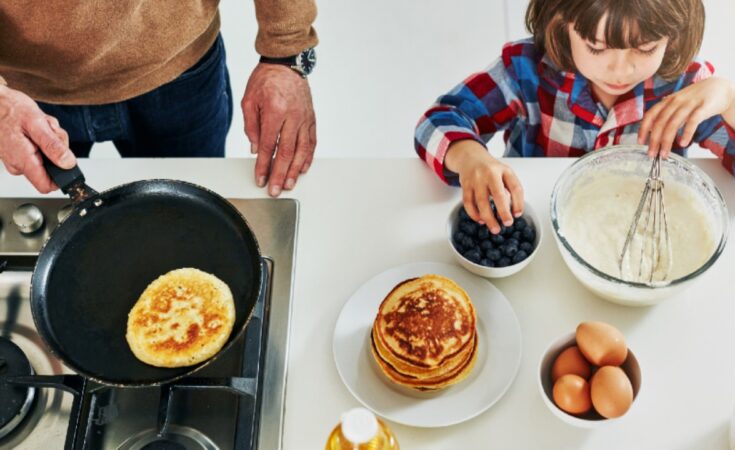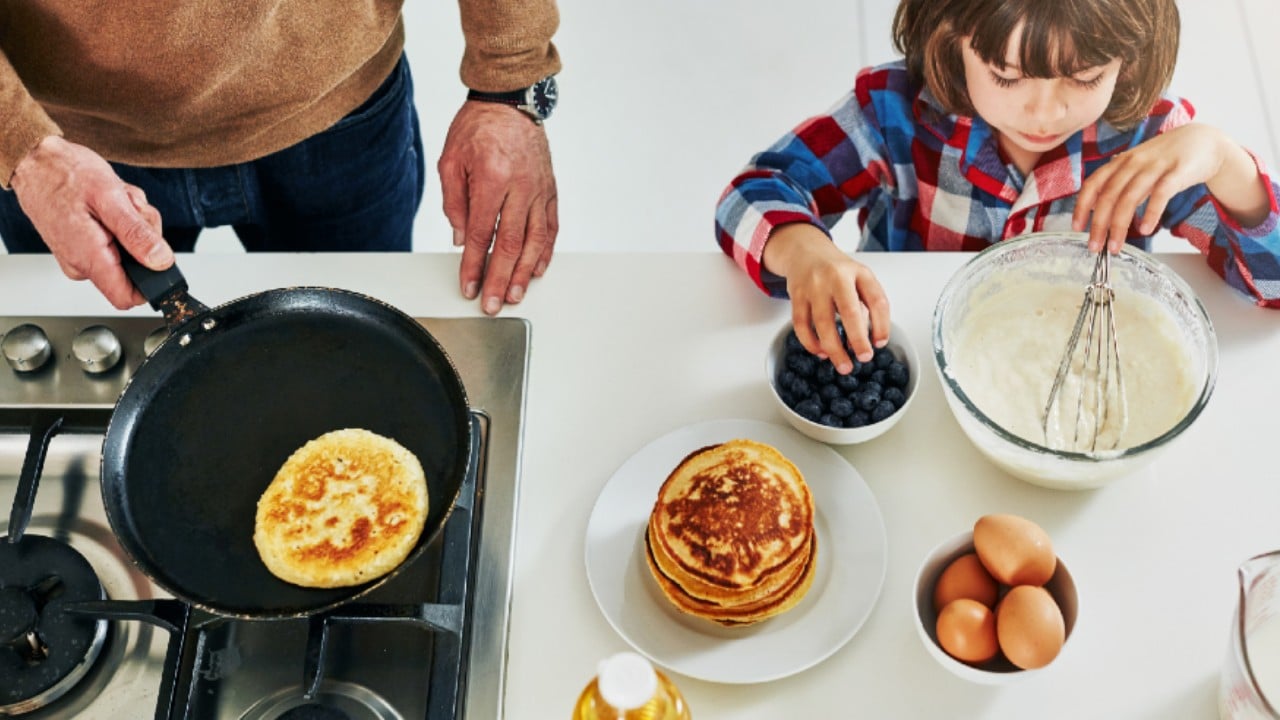I was cooking dinner for my kids when a radio report stopped me, mid-stir: “Why gas stoves are bad for the climate–and you.” My ears perked up as the broadcaster specified that pollutants from gas stoves are especially harmful to kids. I looked down at the blue flames licking up the sides of the simmering pasta pot. Um, oops?
As a parent, my capacity for things-you-really-should-worry-about feels entirely maxed out. Is it really so bad? I wondered. And why am I only hearing about this now?
But it turns out multiple studies have found that gas stoves emit indoor air pollutants including methane gas, which is bad for the environment, and nitrogen oxide particles, which are bad for our lungs. In fact, these particles can decrease lung function and trigger or exacerbate asthma in kids, with symptoms such as wheezing, chest tightness and shortness of breath. Some gas stoves can leak methane continuously—even when the burners aren’t in use.
Anne Hicks, a paediatric lung doctor in Edmonton and the clinical lead at the Children’s Environmental Health Clinic at the University of Alberta, says that studies examining gas stoves and indoor air quality have actually been around since the 1990s.
It’s become the topic du jour though, partly because of a new study out of Stanford University in January 2022, which sparked media attention when researchers found that gas stoves emitted alarming levels of methane gas, which is a greenhouse gas that’s bad for the environment.
While all of this was news to me, it’s not surprising to an expert like Hicks, who studies environmental exposures and respiratory outcomes in children. “There’s a lot of fuel-burning sources of air pollution inside our homes, and all of them have an impact on children,” says Hicks, who’s also an assistant professor in paediatric respiratory medicine.
The good news? “It’s not as if families need to go out and remove their gas stoves today.” But understanding gas appliances and their potential effects can help you make the best decisions for your family. Here is what you should know.
How do gas stoves work?
The natural gas that powers a household appliance like a gas range is mostly methane (with a few other hydrocarbons in the mix). That burning blue flame releases carbon monoxide, sulfur dioxide, traces of formaldehyde, nitrogen oxides and microscopic particles, or aerosols, of soot.
One often-cited study on emissions from gas stoves was published in 2018 by Tara Kahan, an associate professor at the University of Saskatchewan and an environmental analytical chemist who studies indoor air quality.
“We were looking at nitrogen oxides specifically—similar to what makes up smog,” says Kahan. That’s because nitrogen oxide can exacerbate asthma and even, with long-term exposure, cause asthma.
“These markers of bad air quality went up when people were cooking, and they lingered even when the stove was turned off,” says Kahan. “Most of us had gas stoves at the time, so we were upset when we saw the results.”
How bad is my gas stove for my kids?
Kahan, who has a six-year-old daughter, says more studies are needed to determine the exact health impacts for families. “Are there immediate detrimental effects? Probably not,” she says. “But is it bad over years and years of use? Maybe. We don’t know. It’s a newer area of study.”
Hicks agrees it’s a tricky question to answer, because there’s no way to tell whether a person’s lung damage or inflammation is from gas stoves or something else, and because respiratory problems like asthma are what’s called “epigenetic—this means it’s both nature and nurture.”
Family history of asthma, and then the different exposures and triggers in your lifetime, all have an effect, she explains. Do you live in a high-traffic city with lots of outdoor air pollution? Are wildfires common in your area? Does anyone smoke inside the home? Do you have a wood-burning stove as well as a gas range? All of these things can contribute to our susceptibility to lung diseases.
But even though we don’t know exactly how gas stoves might affect each individual, because lung damage is cumulative over time, looking at all the sources of air pollution in, and near, your home is wise, experts agree.
Should you get rid of your gas stove immediately?
No, says Hicks. But the health—and environmental—effects of gas appliances are definitely worth considering the next time you’re shopping to replace appliances.
This is especially the case if you have a family history of allergies or asthma, including things like hay fever, food allergies, or even eczema—as your kids are more likely to be susceptible to asthma in the first place, so it’s a good idea to be more mindful of indoor air quality in general.
“Wood-burning fireplaces, smoking or vaping tobacco or cannabis products, or simply having an attached garage instead of a detached one—all of these things also contribute to indoor air pollution,” she says.
One silver lining of the COVID pandemic, and even the wildfires in Western Canada, she says, is that parents are generally more mindful of indoor and outdoor air quality these days.
Another consideration is the age of your kids, as babies and toddlers are also more susceptible to environmental exposures, says Hicks. Their airways are smaller, and for kids with asthma, getting a run-of-the-mill cold triggers the airway to swell and narrow. Your windpipe is the size of your little finger, and in kids, it may only be 3 or 3.5 mm wide, she explains—that’s smaller than the width of a drinking straw. A virus can also cause extra mucus, which can block your breathing, and that’s why some kids get sicker. Plus, many babies and toddlers are just building up their immunity to common viruses.
But it’s never too late, she says, to improve indoor air quality for the whole family, no matter how old your kids are. Parents in the home can benefit from cleaner air, too.
Alternatives to gas stoves
If you are planning to replace your gas stove, you’ll be looking at either an electric stove or an induction stove. Electric stoves have coil burners (usually covered with a glass or ceramic cooktop) and are the less expensive of the two options. An induction cooktop uses copper coils which create a magnetic current with the pot or pan and heats the cookware directly. This provides quick, even heating, but induction cooktops require specific cookware, which is a potential added expense.
According the data from the Stanford study, it’s not helpful to simply replace an old gas stove with a new one. It compared newer models of gas stoves (about three years old) with older gas models (more like 30 years old) and did not find a compelling difference between the two. It also didn’t matter whether you bought a fancier, more expensive gas stove or an inexpensive one.
How else can I mitigate the effects of gas stoves?
If you have a gas stove that’s sticking around, there are still ways to reduce the potential negative effects. Both Kahan and Hicks say we should always turn the hood fan on when we’re cooking on a gas range, which helps ventilate your kitchen and reduces both the aerosols produced when cooking and the nitrogen oxide.
Kahan also suggests opening the windows in your kitchen, which will help increase the ventilation. Using a high-quality air purifier with a HEPA filter in the kitchen will help reduce the aerosols as they are released by the stove, she says, but it won’t address the nitrogen oxides. You could also keep air purifiers in the kids’ bedrooms and/or main play space and living areas for general air quality purposes.
To reduce the amount you are using your gas stove, you can use an electric kettle instead of a kettle that goes on a stove burner, cook more microwaveable recipes, or opt for a countertop induction burner (which you plug in). Popular countertop appliances such as the Instant Pot or air fryer are also good alternatives.
“Our house came with a gas stove, and I’m not going to go and rip it out immediately,” says Hicks. “But I’m keeping the hood fan on, and I’m using the Crockpot instead of cooking soup on the stove all afternoon, which also decreases our family’s carbon footprint.”
Kahan also says that cooking on the back burners of a gas stove is better than using the front burners, because those gasses are better captured by the stove’s hood fan.
You could also confirm that your range’s hood fan does in fact ventilate directly outside, says Kahan, and isn’t just pumping the same air back inside. “If it’s what’s called a ‘recirculating hood,’ those don’t tend to do much good.”
Do I also need to worry about my gas hot water heater, gas furnace, or a gas fireplace?
These also are likely to leak a bit, but since they all have a vent or chimney that leads to the outside, and they’re usually in the basement (where most families don’t spend as much time as the kitchen), the indoor air pollution generated isn’t as bad for your family’s health—just the environment. But the Stanford researchers do plan on studying this further in the future.
This may feel overwhelming, but it’s all about moderation and mitigation, says Hicks. “Life is a bit hazardous. It’s about finding the things you CAN fix, and making life as safe as you can.”
Stay in touch
Subscribe to Today’s Parent’s daily newsletter for our best parenting news, tips, essays and recipes.
= 0;if(!is_postback){return;}var form_content = jQuery(this).contents().find(‘#gform_wrapper_13’);var is_confirmation = jQuery(this).contents().find(‘#gform_confirmation_wrapper_13’).length > 0;var is_redirect = contents.indexOf(‘gformRedirect(){‘) >= 0;var is_form = form_content.length > 0 && ! is_redirect && ! is_confirmation;var mt = parseInt(jQuery(‘html’).css(‘margin-top’), 10) + parseInt(jQuery(‘body’).css(‘margin-top’), 10) + 100;if(is_form){jQuery(‘#gform_wrapper_13’).html(form_content.html());if(form_content.hasClass(‘gform_validation_error’)){jQuery(‘#gform_wrapper_13’).addClass(‘gform_validation_error’);} else {jQuery(‘#gform_wrapper_13’).removeClass(‘gform_validation_error’);}setTimeout( function() { /* delay the scroll by 50 milliseconds to fix a bug in chrome */ jQuery(document).scrollTop(jQuery(‘#gform_wrapper_13’).offset().top – mt); }, 50 );if(window[‘gformInitDatepicker’]) {gformInitDatepicker();}if(window[‘gformInitPriceFields’]) {gformInitPriceFields();}var current_page = jQuery(‘#gform_source_page_number_13’).val();gformInitSpinner( 13, ‘https://www.todaysparent.com/wp-content/plugins/gravityforms/images/spinner.gif’ );jQuery(document).trigger(‘gform_page_loaded’, [13, current_page]);window[‘gf_submitting_13’] = false;}else if(!is_redirect){var confirmation_content = jQuery(this).contents().find(‘.GF_AJAX_POSTBACK’).html();if(!confirmation_content){confirmation_content = contents;}setTimeout(function(){jQuery(‘#gform_wrapper_13’).replaceWith(confirmation_content);jQuery(document).scrollTop(jQuery(‘#gf_13’).offset().top – mt);jQuery(document).trigger(‘gform_confirmation_loaded’, [13]);window[‘gf_submitting_13’] = false;}, 50);}else{jQuery(‘#gform_13’).append(contents);if(window[‘gformRedirect’]) {gformRedirect();}}jQuery(document).trigger(‘gform_post_render’, [13, current_page]);} );} );]]>
Read The Full Article Here



































